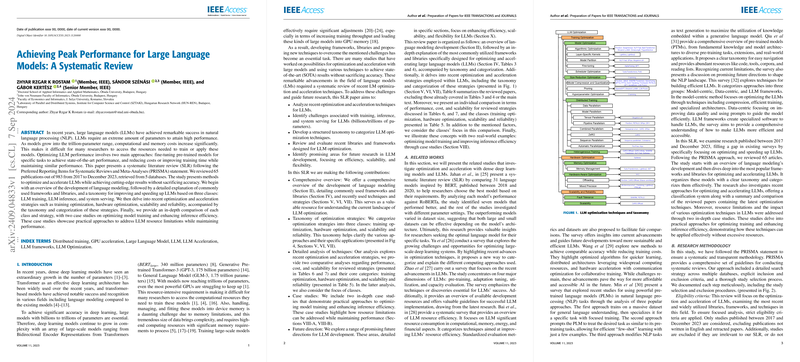Achieving Peak Performance for LLMs: A Systematic Review
Introduction
The paper "Achieving Peak Performance for LLMs: A Systematic Review" authored by Rostam, Szénási, and Kertész, provides a comprehensive exploration of optimization techniques for LLMs. The focus is on mitigating the challenges associated with the exponential growth in model parameters, especially as these models extend into the trillion-parameter range. By following the PRISMA guidelines, the authors reviewed 65 publications from 2017 to December 2023, aiming to present methods that optimize and accelerate LLM performance without sacrificing accuracy. This review is structured around the three principal phases of model lifecycle: training, inference, and system serving.
Training Optimization
The authors identified several strategies for optimizing LLM training. These include:
- Model Optimization: This involves refining the model’s architecture and parameters to enhance performance. Techniques such as algorithmic optimization, layer-specific kernels, model partitioning, and fine-tuning are detailed. For instance, the paper highlights the SparseGPT framework, which accomplishes significant model sparsity using a one-shot pruning method, and AlphaTuning, which combines quantization with fine-tuning to reduce memory footprint while maintaining performance.
- Size Reduction Optimization: Approaches like model compression, quantization, and pruning are discussed. The FlexGen framework, for example, uses 4-bit quantization compression to effectively handle resource constraints. Another notable method is GPTQ, which provides highly efficient post-training quantization, enabling inference of large models on a single GPU.
- Distributed Training: Various parallelism techniques are explored to manage the computational burden. The paper discusses data parallelism, tensor parallelism, and pipeline parallelism, with notable frameworks like Megatron-LM employing these strategies to distribute training workloads across multiple GPUs.
- Heterogeneous Training: Techniques such as ZeRO-Offload, which leverages GPU and CPU memory for large model training on a single GPU, are shown to democratize access to LLM training by significantly reducing computational requirements.
Inference Optimization
To optimize LLM inference, the paper reviews several frameworks that enhance efficiency through:
- Resource Optimization: FlexGen exemplifies how efficient utilization of CPU, GPU, and disk resources can achieve substantial throughput gains. Additionally, the ByteTransformer optimizes memory and computation specifically for BERT-like transformers.
- Algorithmic Improvements: Strategies like sequence-length-aware allocation and dynamic memory management in frameworks such as TurboTransformers and LightSeq2 are highlighted for their effectiveness in managing varying input lengths.
- Hardware Optimizations: Techniques such as mixed-precision training and advanced memory management reduce resource consumption while maintaining model accuracy. The FP8-LM framework, for instance, introduces an FP8 automatic mixed-precision framework that significantly enhances training efficiency.
System Serving and Deployment
For the deployment and serving of LLMs, the review identifies key challenges and proposes solutions such as:
- Memory Management: Innovations like PagedAttention, which manage the KV cache efficiently, are particularly noteworthy for handling large models and long sequences.
- Scalability: The paper discusses distributed systems and load-balancing strategies to efficiently handle multiple user requests. Frameworks like PETALS facilitate collaborative inference, optimizing scalability across a network of devices.
Case Studies
Two case studies provide practical examples of optimization techniques:
- SparseGPT for Model Training: This technique involves one-shot pruning to achieve significant sparsity without extensive retraining, demonstrating its capacity to reduce model size while maintaining accuracy.
- QMoE for Inference Efficiency: The QMoE framework compresses large MoE models to sub-1-bit per parameter, enabling efficient execution on standard hardware with minimal performance loss.
Future Directions
The paper concludes with recommendations for future research, emphasizing enhanced efficiency, scalability, and flexibility. Key areas include hybrid processing techniques, advanced memory management, adaptive parallelism, and dynamic quantization methods. These suggestions aim to further democratize access to LLM training and deployment, making these powerful models more broadly accessible and practically applicable.
Conclusion
Rostam, Szénási, and Kertész's systematic review provides a vital resource for researchers aiming to optimize LLM performance. By dissecting the latest frameworks and techniques, the paper offers a structured approach to addressing the computational and memory challenges of large-scale models, paving the way for future advancements in AI.
